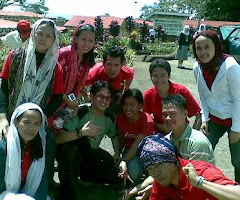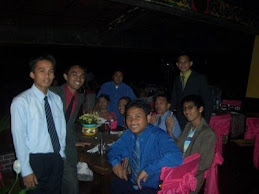Hi, Nat Sci - Ll2 people!
Here's the slideshow of our pictures taken on the last day of our class. Sorry if there were things that I did which cause you headaches. You should understand that all of them had sincere ambition. And that is to help you shape yourselves into becoming a diamond, glittering, vulnerable and attractive.
Thank you for bearing with me throughout this semester.
Happy holidays!
And good luck as you enter new chapter in your journey in the academe.
:-)
captured last moments together - slideshows
Tuesday, March 12, 2013
Nat Sci 1 - Ll2 Final Exam Top 5
Congratulations!
... to the top 5 scorers of Nat Sci 1 Final Exam!
Name Score
CABARLES, Mary Joy Abogada
|
92
|
BALINDONG, Elham Sidic
|
75
|
BERAME, Sherilyn Yongco
|
74
|
MOSEP, Rushelle Vergara
|
73
|
TORRENUEVA, Ma. Glaide Pepito
|
70
|
Wednesday, March 6, 2013
See Me on Monday (Mar 11)
To all my students this semester who have unfinished business with me,
(these people are:
1. Phys 21.1 students who have not yet passed their previous activities
2. Phys 11.1 students who have missed two or three activities
3. Nat Sci 1 - Ll2 who have not passed their last assignment, and those who did not claim their balance during Final Exam)
please see me on Monday (March 11, '13). I will be in the office from 8:00 AM til noon.
*Note: Nat Sci 1 Final Exam topnochers shall be posted here next week. ^_^
(these people are:
1. Phys 21.1 students who have not yet passed their previous activities
2. Phys 11.1 students who have missed two or three activities
3. Nat Sci 1 - Ll2 who have not passed their last assignment, and those who did not claim their balance during Final Exam)
please see me on Monday (March 11, '13). I will be in the office from 8:00 AM til noon.
*Note: Nat Sci 1 Final Exam topnochers shall be posted here next week. ^_^
Monday, March 4, 2013
Nat Sci 1 Last Assignment Samples
Good Morning, everyone!
A. Dancing Wire
1. Take two identical water glasses and use a measuring cup to fill each with the exact same amount of water.
2. Cut a piece of thin wire that's inch longer than the diameter of one of the glasses.
3. Place the wire across the top center of one glass.
4. Bend the wire so 1/4 inch hangs over each side to keep the wire in place.
5. Rub your finger along the outer rim of the second glass to make sound and watch the wire move. Since both glasses have equal amounts of water, they both have the same natural frequency. Sound is transferred from one glass to the next and thus the vibrations cause the wire to move
B. Seeing Sound
This is a simple experiment that requires very little setup and only three materials.
1. Tie a piece of thread to some tissue paper and hold the tissue paper by the thread in front of a speaker.
2. Turn on the music and observe what happens to the tissue paper.
3. Try different types of music at different volumes and see if there's any change to the paper.
4. The tissue should move when the music is played.
 C. Model Eardrum
C. Model Eardrum
1. Stretch plastic wrap tightly over a wide mouthed container like a bowl or pot.
2. Place 20 to 30 grains of rice on top of the plastic.
3. Bang a metal cookie sheet or something equally as loud to make noise close to the plastic wrap.
4. Watch as the grains of rice move. The plastic wrap reacts to sound waves in a way similar to the human eardrum.
5. Have your friend make noises to see if they can make the rice move.
D. Sound Waves Blowing Out a Candle
Materials To make a candle snuffer, you need a 2-liter plastic soft drink bottle, plastic wrap, a rubber band that will fit tightly around the largest part of the bottle, scissors, a small candle in a holder and matches or a lighter.
1. Cut off the base of the bottle.
2. Poke the sharp end of a pair of scissors through the plastic to make an opening for your scissors. The edge of the plastic can be sharp, so use caution as you cut.
3. Stretch a piece of plastic wrap tightly over the cut end of the bottle, leaving a small overhang. Secure the plastic wrap around the bottle's circumference with a rubber band.
4. Stand the candle on a table or stable flat surface, and then light the candle.
5. Point the neck end of the bottle at the flame, about two-inches away from the flame.
6. Sharply tap the plastic wrap with your finger as if it is a drum. Listen for the sound you create and observe the candle's flame.
Reference:
www.ehow.com
Here's an example of the video you're going to make. To make it really authentic you should be seen in the video. ^_^
To make things easier for you, I have listed below some of the simplest demonstrations. You may choose one among these. Or if you know something else, better than any of these, perform that. It's really up to you.One group should perform only one .
Hope you'll have fun doing this!1. Take two identical water glasses and use a measuring cup to fill each with the exact same amount of water.
2. Cut a piece of thin wire that's inch longer than the diameter of one of the glasses.
3. Place the wire across the top center of one glass.
4. Bend the wire so 1/4 inch hangs over each side to keep the wire in place.
5. Rub your finger along the outer rim of the second glass to make sound and watch the wire move. Since both glasses have equal amounts of water, they both have the same natural frequency. Sound is transferred from one glass to the next and thus the vibrations cause the wire to move
B. Seeing Sound
This is a simple experiment that requires very little setup and only three materials.
1. Tie a piece of thread to some tissue paper and hold the tissue paper by the thread in front of a speaker.
2. Turn on the music and observe what happens to the tissue paper.
3. Try different types of music at different volumes and see if there's any change to the paper.
4. The tissue should move when the music is played.
 C. Model Eardrum
C. Model Eardrum1. Stretch plastic wrap tightly over a wide mouthed container like a bowl or pot.
2. Place 20 to 30 grains of rice on top of the plastic.
3. Bang a metal cookie sheet or something equally as loud to make noise close to the plastic wrap.
4. Watch as the grains of rice move. The plastic wrap reacts to sound waves in a way similar to the human eardrum.
5. Have your friend make noises to see if they can make the rice move.
D. Sound Waves Blowing Out a Candle
Materials To make a candle snuffer, you need a 2-liter plastic soft drink bottle, plastic wrap, a rubber band that will fit tightly around the largest part of the bottle, scissors, a small candle in a holder and matches or a lighter.
1. Cut off the base of the bottle.
2. Poke the sharp end of a pair of scissors through the plastic to make an opening for your scissors. The edge of the plastic can be sharp, so use caution as you cut.
3. Stretch a piece of plastic wrap tightly over the cut end of the bottle, leaving a small overhang. Secure the plastic wrap around the bottle's circumference with a rubber band.
4. Stand the candle on a table or stable flat surface, and then light the candle.
5. Point the neck end of the bottle at the flame, about two-inches away from the flame.
6. Sharply tap the plastic wrap with your finger as if it is a drum. Listen for the sound you create and observe the candle's flame.
Reference:
www.ehow.com
Sunday, March 3, 2013
Nat Sci 1 - Ll2 Powerpoint file on sound wave
To download the powerpoint file that I was using on our last topic, please click either of these:
1. For 2010 format, click here.
2. For 2003 format, click here
Note:
*If you are using Microsoft Office 2010, choose 2010 format, otherwise choose 2003.
*These are all compressed (so that I could upload it easily). To view it, you should extract it first e. g. using WinRAR.
*The video clips may not work because they were hyperlinked to the original file in my computer. Nevertheless, the video clips I've shown you in the last 4 slides are extracted from a youtube video uploaded by Pauli1982, shown below.
1. For 2010 format, click here.
2. For 2003 format, click here
Note:
*If you are using Microsoft Office 2010, choose 2010 format, otherwise choose 2003.
*These are all compressed (so that I could upload it easily). To view it, you should extract it first e. g. using WinRAR.
*The video clips may not work because they were hyperlinked to the original file in my computer. Nevertheless, the video clips I've shown you in the last 4 slides are extracted from a youtube video uploaded by Pauli1982, shown below.
Nat Sci - Ll2 Last Assignment
Answer the following.
I. Show your solutions.
1. What is the frequency, in hertz, that corresponds to each of the following periods? (a) 0.10 s (b) 5 s.
2. What is the period, in seconds, that corresponds to each of the following frequencies? (a) 10Hz, (b) 0.2 Hz.
3. (a) What is the wavelength of a 340-Hz tone in air? (b) What is the wavelength of a 34,000-Hz ultrasonic wave in air?
4. While playing a game in a golf course, a friend of yours is 408 m away from you. You shout at her saying her name “Jayne!” How long will it take before she hears her name?
II. In your own words, concisely discuss the following.
1. If the Moon blew up, why would we not hear it? (Hint: Sound wave needs medium so that it can travel.)
2. What happens to the wavelength of sound as the frequency increases?
I. Show your solutions.
1. What is the frequency, in hertz, that corresponds to each of the following periods? (a) 0.10 s (b) 5 s.
2. What is the period, in seconds, that corresponds to each of the following frequencies? (a) 10Hz, (b) 0.2 Hz.
3. (a) What is the wavelength of a 340-Hz tone in air? (b) What is the wavelength of a 34,000-Hz ultrasonic wave in air?
4. While playing a game in a golf course, a friend of yours is 408 m away from you. You shout at her saying her name “Jayne!” How long will it take before she hears her name?
II. In your own words, concisely discuss the following.
1. If the Moon blew up, why would we not hear it? (Hint: Sound wave needs medium so that it can travel.)
2. What happens to the wavelength of sound as the frequency increases?
Friday, March 1, 2013
My first try in writing mathematical formula in this blog
Fascinated by a way to write formula in blogspot.com, here's my very first.
The codes used are based on the LATEX and simulated via java extension file installed in this blog. ^_^
$latex \displaystyle S(n)=\sum_{k=1}^{n}{\frac{1}{T_{k}}=\sum_{k=1}^{n}{\frac{6}{k(k+1)(k+2)}$
The codes used are based on the LATEX and simulated via java extension file installed in this blog. ^_^
$latex \displaystyle S(n)=\sum_{k=1}^{n}{\frac{1}{T_{k}}=\sum_{k=1}^{n}{\frac{6}{k(k+1)(k+2)}$




 Time in Manila, Philippines
Time in Manila, Philippines 



